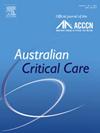Daily prediction of next-day disease severity in critically ill patients: A prospective cohort study
IF 2.7
3区 医学
Q2 CRITICAL CARE MEDICINE
引用次数: 0
Abstract
Background
Predictive models for intensive care unit (ICU) patients mainly focus on mortality, but short-term disease severity is more relevant for day-to-day decision-making.
Aim
The aim of this study was to develop and validate a daily prediction model for next-day disease severity in ICU patients.
Methods
Data from the Simple Intensive Care Studies-II prospective cohort study of acutely admitted critically ill adults, including data collected during the first 7 days of admission such as Sequential Organ Failure Assessment (SOFA) score–related measurements, were used to fit a mixed-effects logistic regression model for next-day deterioration. Deterioration was defined as a decline in the total (≥2) and organ-specific (≥1) SOFA scores. Performance was evaluated using the area under the receiver operating characteristic curve (AUC), calibration plots, and decision curve analysis.
Results
A total of 1009 patients were included. The final predictive model for overall next-day deterioration included six predictors (the total SOFA score on the current day, the minimum value of arterial pH, Glasgow Coma Scale score, mean arterial blood pressure, mechanical ventilation, and its effect differing between the first and subsequent ICU days). The model achieved an AUC of 0.74 (95% confidence interval: 0.70−0.78). In the decision curve analysis, within probability thresholds of 0.2–0.5, the model showed a higher net benefit than did strategies of treating all patients or treating no patients. Organ-specific prediction models for next-day deterioration in respiration, cardiovascular, and renal function showed slightly better performance than the overall model (AUCs: 0.79, 0.79, and 0.81, respectively).
Conclusions
Daily prediction models can predict next-day disease severity in overall, respiration, cardiovascular, and renal function amongst ICU patients. They offer clinical benefits within a range of probability thresholds and could support decision-making for ICU physicians.
危重患者次日疾病严重程度的每日预测:一项前瞻性队列研究
背景重症监护室(ICU)患者的预测模型主要关注死亡率,但短期疾病严重程度与日常决策更相关。目的本研究旨在开发和验证ICU患者第二天疾病严重程度的每日预测模型。方法使用简单重症监护研究II前瞻性队列研究的数据,包括入院前7天收集的数据,如序贯器官衰竭评估(SOFA)评分相关测量值,来拟合第二天恶化的混合效应逻辑回归模型。恶化被定义为SOFA总评分(≥2)和器官特异性评分(≥1)的下降。使用受试者工作特征曲线下面积(AUC)、校准图和决策曲线分析来评估性能。结果共纳入1009例患者。第二天总体恶化的最终预测模型包括六个预测因素(当天的总SOFA评分、动脉pH值的最小值、格拉斯哥昏迷评分、平均动脉血压、机械通气及其在第一天和随后的ICU天数之间的影响不同)。该模型的AUC为0.74(95%置信区间:0.70-0.78)。在决策曲线分析中,在0.2-0.5的概率阈值内,该模型显示出比治疗所有患者或不治疗任何患者的策略更高的净收益。呼吸、心血管和肾功能第二天恶化的器官特异性预测模型显示,其性能略优于整体模型(AUC:0.79、0.79和0.81)。结论每日预测模型可以预测ICU患者第二天的整体疾病严重程度、呼吸、心血管和肾功能。它们在一定概率阈值范围内提供临床益处,并可以支持ICU医生的决策。
本文章由计算机程序翻译,如有差异,请以英文原文为准。
求助全文
约1分钟内获得全文
求助全文
来源期刊

Australian Critical Care
NURSING-NURSING
CiteScore
4.90
自引率
9.10%
发文量
148
审稿时长
>12 weeks
期刊介绍:
Australian Critical Care is the official journal of the Australian College of Critical Care Nurses (ACCCN). It is a bi-monthly peer-reviewed journal, providing clinically relevant research, reviews and articles of interest to the critical care community. Australian Critical Care publishes peer-reviewed scholarly papers that report research findings, research-based reviews, discussion papers and commentaries which are of interest to an international readership of critical care practitioners, educators, administrators and researchers. Interprofessional articles are welcomed.
 求助内容:
求助内容: 应助结果提醒方式:
应助结果提醒方式:


